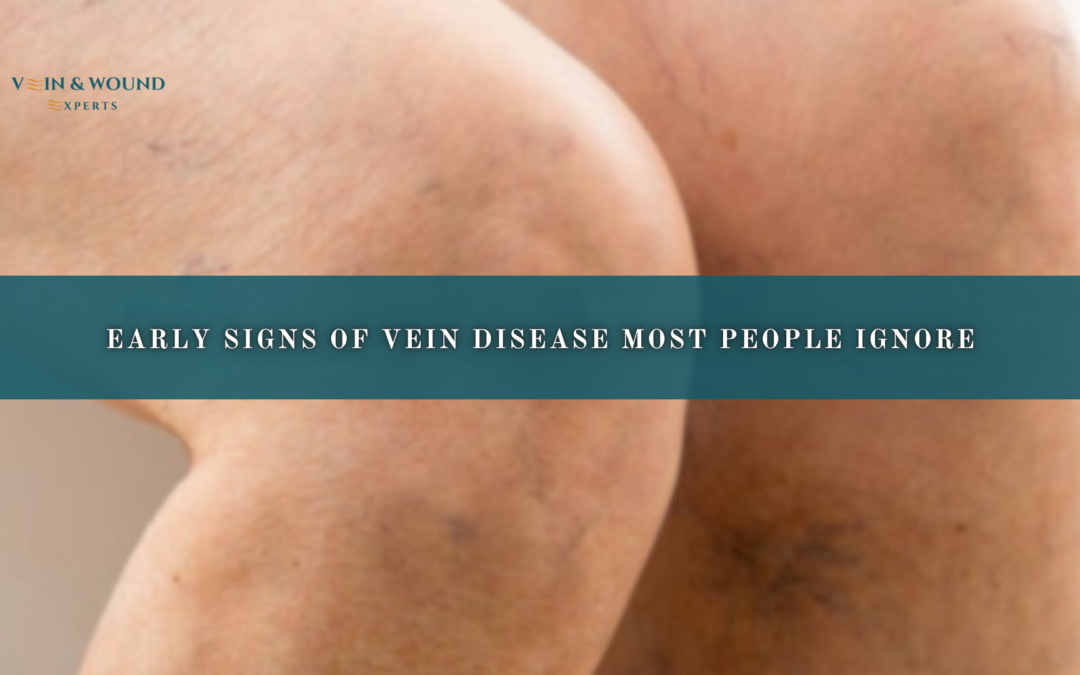Early Symptoms of Vein Disease
Noticing changes in the legs can be easy to dismiss, especially when the symptoms seem mild or temporary. However, the early signs of vein disease often begin long before visible veins appear. These changes may show up subtly through skin discomfort, nighttime restlessness, or swelling that comes and goes. Understanding them early helps prevent more advanced vascular concerns in the future, including discomfort that affects daily life.
🩺 Subtle Physical Changes That Often Go Unnoticed
One of the first signals people experience is a shift in how their legs feel at the end of the day. This may show up as mild heaviness, a dull ache, or a need to elevate the legs more frequently. These symptoms often appear after long periods of sitting or standing, when the leg veins struggle to maintain healthy blood flow. Although the discomfort might fade with rest, its repeated pattern is a sign that the veins may not be functioning as efficiently as they should.
Skin texture is another early indicator. Some people notice that the skin around their ankles or calves feels slightly tighter or looks more irritated after activity. While easy to overlook, these changes can reflect developing circulation challenges. Small patches of redness, dryness, or itching may appear before any visible veins form.
🧬 When Family History and Hormonal Shifts Play a Role
Genetics influence vein structure, which means individuals with a parent or sibling who has dealt with vein problems may be more likely to develop them. Even without visible veins, inherited vein weakness can cause discomfort or swelling earlier in life.
Hormonal changes especially pregnancy, menopause, or certain medications can also contribute. These changes may cause fluid retention and increased vein pressure, creating early symptoms that mimic fatigue or muscle strain. Although these conditions do not automatically lead to severe vascular problems, they can create an environment where the veins struggle to maintain normal function.
🌙 Nighttime Discomfort Many People Ignore
Symptoms often become more noticeable in the evening. Some individuals feel a deep, nagging ache or sense of restlessness in their legs. Others experience nighttime cramps that disrupt sleep. These patterns can reflect developing vein dysfunction even before visible signs appear.
This discomfort can sometimes be confused with muscle tension or daily fatigue. However, when it becomes repetitive, it may indicate early changes that can progress if left unaddressed.
💧 Role of Poor Circulation in Early Leg Symptoms
The circulatory system works continuously to move blood back toward the heart, and the leg veins carry much of that responsibility. When the flow slows or struggles against gravity, fluid can accumulate in the lower limbs. This contributes to sensations like swelling, tightness, or a heavy feeling in the legs.
Even small changes in blood flow can signal underlying strain within the veins. Temporary relief after lifting the legs is common, but recurring symptoms usually point toward deeper venous involvement that should be evaluated.
🩹 Differentiating Surface-Level Symptoms from Chronic Conditions
Not all leg discomfort points to advanced disease, and visible veins do not always appear in the early stages. However, when symptoms persist, a medical examination becomes essential to rule out early chronic vein insufficiency, a condition where the valves in the leg veins do not work effectively.
Before major signs like bulging veins or ongoing swelling occur, many people notice changes that they assume are temporary. Sluggish healing of minor skin injuries, patches of discoloration, or increased sensitivity in the lower legs can appear months or even years before more obvious symptoms form.
✨ Gentle Lifestyle Adjustments That Make a Difference
Simple changes often help relieve early symptoms and protect overall leg health. Staying active, stretching during long periods of sitting, and elevating the legs after activity can help reduce discomfort. Wearing supportive footwear and maintaining hydration also support healthy circulation.
For individuals who spend most of their day sitting or standing, small breaks to move the legs can significantly improve comfort. Monitoring these early signals helps determine whether symptoms remain temporary or gradually become more consistent.
🌟 Understanding Your Body’s Early Warnings
Everyday leg discomfort is easy to overlook, but paying attention to these subtle changes can protect long-term vascular health. Noticing shifts such as heaviness, tightened skin, or nighttime cramps allows you to address concerns before they progress into more persistent problems. For individuals who want clarity about what these early patterns might indicate, Vein & Wound Experts in Downey offers clinical evaluation to help determine whether these signals deserve further attention without assuming anything is already advanced.

Andy Sharifi
Position
